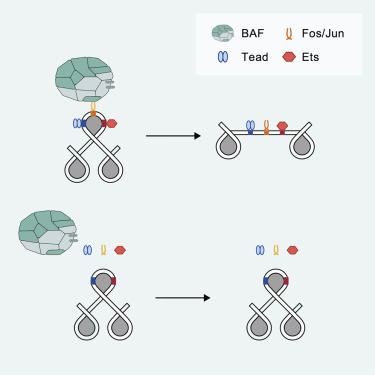Molecular Cell ( IF 16.0 ) Pub Date : 2017-12-21 , DOI: 10.1016/j.molcel.2017.11.026 Thomas Vierbuchen , Emi Ling , Christopher J. Cowley , Cameron H. Couch , Xiaofeng Wang , David A. Harmin , Charles W.M. Roberts , Michael E. Greenberg

|
Enhancer elements are genomic regulatory sequences that direct the selective expression of genes so that genetically identical cells can differentiate and acquire the highly specialized forms and functions required to build a functioning animal. To differentiate, cells must select from among the ∼106 enhancers encoded in the genome the thousands of enhancers that drive the gene programs that impart their distinct features. We used a genetic approach to identify transcription factors (TFs) required for enhancer selection in fibroblasts. This revealed that the broadly expressed, growth-factor-inducible TFs FOS/JUN (AP-1) play a central role in enhancer selection. FOS/JUN selects enhancers together with cell-type-specific TFs by collaboratively binding to nucleosomal enhancers and recruiting the SWI/SNF (BAF) chromatin remodeling complex to establish accessible chromatin. These experiments demonstrate how environmental signals acting via FOS/JUN and BAF coordinate with cell-type-specific TFs to select enhancer repertoires that enable differentiation during development.
中文翻译:

AP-1转录因子和BAF复杂介导信号依赖的增强子选择。
增强子是指导基因选择性表达的基因组调控序列,因此遗传上相同的细胞可以分化并获得构建功能动物所需的高度专门化的形式和功能。为了区分,细胞必须从10 6中进行选择。增强子在基因组中编码成千上万个增强子,这些增强子驱动赋予其独特功能的基因程序。我们使用一种遗传方法来鉴定成纤维细胞中增强子选择所需的转录因子(TF)。这表明,广泛表达的生长因子诱导型TFs FOS / JUN(AP-1)在增强子选择中起着核心作用。FOS / JUN通过协同结合核小体增强子并募集SWI / SNF(BAF)染色质重塑复合物来建立可及的染色质,从而选择增强子以及细胞类型特异性TF。这些实验证明了通过FOS / JUN和BAF作用的环境信号如何与细胞类型特异性TF协同作用,以选择在发育过程中能够分化的增强子库。



























 京公网安备 11010802027423号
京公网安备 11010802027423号